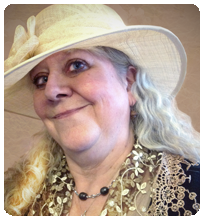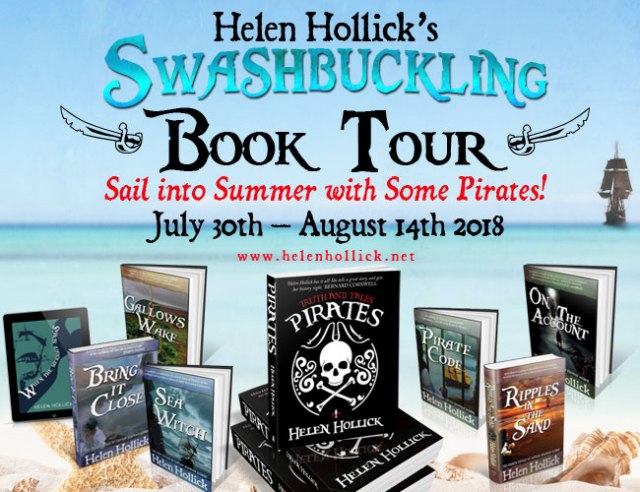Helen Hollick is a much-published and much-loved author of historical fiction and pirate-based adventure fantasy, and is a good friend to all new authors – like me! Today, I am delighted that Helen is ‘dropping anchor’ on my blog with a guest post. To explain…

Helen has written a series of nautical Voyages based around her fictional pirate, Captain Jesamiah Acorne and his ship, Sea Witch, but her latest UK release in paperback is a non-fiction book – Pirates: Truth and Tales published by Amberley Press, which explores our fascination with the real pirates and those who are favourites in fiction. Today, Helen drops anchor for another interesting addition to her on-line two-week Voyage around the Blogs with a pirate or two for company…
We think of pirates as those of the ‘Golden Age’ – the early 18th Century, or the swashbuckling movie heroes such as Errol Flynn and Johnny Depp, but piracy is a very old ‘career’, if you can get away with calling it that. Basically, where there was trade and merchants shipping goods by sea there was piracy. That get-rich-quick lure of stealing something rather than working hard to get it.
Having said that, it was probably hard work to be a pirate back in the days of early sail. Those days of seafaring trade – from the Ancient Greeks, through the Roman Empire and the Vikings to the Middle Ages of the thirteenth and fourteenth centuries. Those sailors – merchants, war ships and the pirates – had no compass for a start. No sophisticated rigging and sails. No cannons. No maps.
Trade was undertaken from safe anchorage to safe anchorage. With only a few exceptions, navigation was from visible point to visible point. These sailors braved the North Sea, the Baltic, the Mediterranean. No America as yet, Columbus didn’t open up that trade route until he ‘sailed the ocean blue in fourteen-hundred and ninety-two’, although it is strongly suspected that he knew where he was going and had charts and verbal ‘directions’ to follow. The Norse (the ‘Vikings’) did discover Iceland, Greenland and what is now Canada and the upper part of the East Coast of the United States – but there were no trade routes, so no piracy.
Nations as we think of them now were still evolving and in a state of constant flux in the 1100s, but whoever temporarily ruled as king, duke or emperor, piracy was always a thorn in their various royal backsides. Maritime supremacy by official navies was at an embryonic stage, with no ability or means to oppose wilful piracy.

Some pirates we know of were John Hawley from Dartmouth in Devon and Dorset-born Henry Pay, although they could be described as privateers as, yet again, England was at war with France and they attacked French shipping. The ‘other side’ had their chaps of course, men such as Charles de Savoisy and Pero Nino. An Italian, Margaritone of Brindisi, allied with Sicily’s Norman lords and became a Grand Admiral, promoting himself in 1185 to Count of Cephalonia and Zante. He was captured in 1194 while defending Naples and died in a German prison, while in 1228 the first pirate to be hanged in England was William de Briggeho.
Another known pirate was a Flemish cleric, previously of the Benedictine order, Eustace the Black Monk. He fled his home town of Boulogne and fell in with pirates from the Channel Island of Jersey at some time near 1203. As long as he only plundered French shipping he was permitted to ply his pirate trade in the English Channel when granted a free rein by King John. He upset John, however, and fled to France, where he then served the French king in the same manner. He led a pirate force against the English in 1217, but was caught in a battle near Dover where the English used lime as a weapon. The French fleet was defeated and captured. Eustace was beheaded.
With the problem of pirates escalating, the Germanic cities of the Baltic formed the Hanseatic League in 1241. This was a guild of merchants who were responsible for matters maritime. By the start of the fourteenth century, this trade group had included nineteen ports and the Hanse had become a strong force to be reckoned with. Meanwhile, the English League of the Cinque Ports came into being to protect the trade ports between Dover and Hastings, although this lot did not have the same moralistic code as the Hanseatic League, for they vigilantly protected their own English shipping – but happily plundered everything else. The French, English and Nordic countries were not the only ones to suffer from piracy, the Mediterranean had its share of trouble. Byzantium used pirates during various Holy Wars, and in the 1260s they made up the force of the Emperor’s navy.
Piracy increased during the Hundred Years’ War, which lasted from about 1337 to 1453, and the Hanse found that it had its opponents. The Victual Brothers were a gang of German pirates who attacked Bergen in 1392, and almost succeeded in destroying the Hanseatic League, but they were captured in 1402 by a Hamburg fleet and hanged.
Fifteenth-century pirates also caused trouble for the Scots. King Robert III made the decision to send his second son, James, to France when he was no more than twelve years old following the murder of his elder brother. Pirates captured his ship near Great Yarmouth and sold the boy to the English king, Henry IV. The poor boy, who must have been terrified, was incarcerated in the Tower of London. His father died of grief within a few weeks. Robert’s brother became regent, and Henry ensured the young boy was cared for and educated. He was to remain a prisoner for eighteen years until a ransom was paid for his release. He became James I of Scotland in 1424.
In circa 1450 a man purchased a quantity of fish from Flanders and shipped his purchase to England. He was attacked by pirates who damaged the ship and stole the cargo. Or the earlier date of 1384 when several thousand boxes of raisins and figs, wine, corn and bales of wheat were stolen after a fierce attack upon a shipping merchant. There was piracy in the seas around Norway, Denmark, the Friesian Coast and the Baltic where ships and towns were attacked, although much of this was when one country was at war against another. In these cases piracy – or privateering – was accepted as legal spoils of war.
Piracy continued into the Tudor age – with well-known names such as Grainne O’Malley of Ireland who met with Queen Elizabeth I at Greenwich but refused to bow or curtsey as she considered herself to be an equal, and a name everyone knows: Francis Drake, a master seaman… but was he a privateer or a pirate? The Spanish would definitely say the latter.
© Helen Hollick
Pirates: Truth And Tales published in paperback in the UK July 2018 and November 2018 in the US – but available for pre-order.
Buy the Books: Amazon Author Page (Universal Link) viewAuthor.at/HelenHollick
Sign up for Helen’s Newsletter and be entered for an annual prize draw. One name “picked from the hat” in December will win a £10/$10 Amazon gift voucher. Subscribe here: http://tinyletter.com/HelenHollick
LINKS:
Website: www.helenhollick.net
Main Blog: www.ofhistoryandkings.blogspot.com
Facebook: www.facebook.com/HelenHollickAuthor
Twitter: @HelenHollick
Discovering Diamonds: https://discoveringdiamonds.blogspot.co.uk/
FOLLOW HELEN’S BOOK TOUR:

These links will take you to the Home Page of each blog host – Helen says thank you for their interest and enthusiasm! For exact URL links to each article go to Helen’s website: www.helenhollick.net which will be updated every day of the tour.
30th July: Cryssa Bazos https://cryssabazos.com/ Dropping Anchor to Talk About Pirates
31st July: Anna Belfrage https://annabelfrage.wordpress.com/ Ships That Pass…
1st August: Carolyn Hughes https://carolynhughesauthor.com/blog/ Pirates of the Middle Ages
2nd August: Alison Morton https://alison-morton.com/blog/ From Pirate to Emperor
3rd August: Annie Whitehead https://rwranniewhitehead.blogspot.com/ The Vikings: Raiders or Pirates?
4th August: Tony Riches http://tonyriches.blogspot.co.uk/ An Interview With Helen Hollick (and maybe a couple of pirates thrown in for good measure?)
5th August: Lucienne Boyce http://francesca-scriblerus.blogspot.com/ Anne and Mary. Pirates.
6th August: Laura Pilli http://fieldofbookishdreams.blogspot.co.uk/ Why Pirates?
7th August: Mary Tod https://awriterofhistory.com/ That Essential Element… For A Pirate.
8th August: Pauline Barclay http://paulinembarclay.blogspot.com/ Writing Non-Fiction. How Hard Can It Be?
9th August: Nicola Smith http://shortbookandscribes.uk/ Pirates: The Tales Mixed With The Truth
10th August: Christoph Fischer https://writerchristophfischer.wordpress.com/ In The Shadow Of The Gallows
11th August: Debdatta http://www.ddsreviews.in/ What Is It About Pirates?
12th August: Discovering Diamonds https://discoveringdiamonds.blogspot.co.uk/ It’s Been An Interesting Voyage…
13th August: Sarah Greenwood https://www.amberley-books.com/blog Pirates: The Truth and the Tales
14th August: Antoine Vanner https://dawlishchronicles.com/dawlish-blog/ The Man Who Knew About Pirates
ABOUT HELEN
Helen moved from London in 2013 and now lives with her family in North Devon, in an eighteenth-century farmhouse. First published in 1994, her passion now is her pirate character, Captain Jesamiah Acorne of the nautical adventure series, The Sea Witch Voyages. Helen became a USA Today Bestseller with her historical novel, The Forever Queen (UK title A Hollow Crown) the story of Saxon Queen, Emma of Normandy. Her novel Harold the King (US title I Am The Chosen King) explores the events that led to the 1066 Battle of Hastings. Her Pendragon’s Banner Trilogy, set in the fifth century, is widely praised as a more down-to-earth historical version of the Arthurian legend. She has written three non-fiction books, Pirates: Truth and Tales, Smugglers in Fact and Fiction (to be published 2019) and as a supporter of indie writers, co-wrote Discovering the Diamond with her editor, Jo Field, a short advice guide for new writers. She runs the Discovering Diamonds review blog for historical fiction assisted by a team of enthusiastic reviewers.
Helen is published in various languages.

Thank you Carolyn for giving me such a warm welcome. Those pirates got around to a lot of p[laces and even though this is only the third day of my Voyage Round the Blogs I’m started to feel well-travelled myself!
LikeLike
It’s great to have you aboard, Helen! Yes, by the end of your tour, leaping from ship to ship, even if they are only virtual, you will surely feel that you have travelled the world! But I’m sure too it will have been great fun, for you, your hosts and all your readers…
LikeLiked by 1 person
Fascinating blog with lots of ‘I never knew that’ moments for me! Looking forward to the next stop on the tour.
LikeLiked by 1 person
Thank you for coming aboard, Lucienne!
LikeLiked by 1 person
I think that was one of the really enjoyable things about writing this book,Lucienne – those ‘I never knew that!’moments!
LikeLike
Great article, Helen! Most people don’t think of pirates in the Middle Ages.
LikeLiked by 1 person
I thought that too, Cryssa… But who better to fill that particular knowledge gap than “pirate aficionado” Helen!
LikeLiked by 1 person
I didn’t either, but once I started looking for information I was amazed at what I found!
LikeLiked by 1 person
I just love ‘Eustace the Black Monk’! Well, not him, but his name. His story is crying out for a novel.
Thank you both for such an interesting read.
LikeLiked by 2 people
Pingback: Lucienne Boyce | Anne and Mary: Pirates!